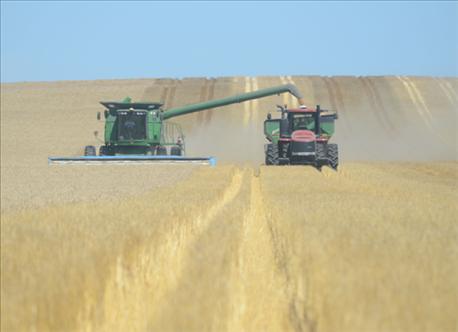
This year's winter wheat crop could set a record for Nebraska. Caroline Brauer, ag promotion coordinator at the Nebraska Wheat Board, notes field averages have ranged from the 40-bushel per acre range up to the high 70s in dryland acres. "On the whole, looking at USDA statistics, if everything goes as well as it has been, we're probably looking at a new average yield statewide," Brauer says. "Our previous record was 49 bushels per acre. It's looking like we could hit 50 or the low 50s."

RECORD CROP: Brent Robertson harvests hard white winter wheat in this field near Elsie in early July. Despite a hot, dry June, Robertson notes this has been one the best wheat crops he's seen. In fact, this year's winter wheat crop could set a record for Nebraska.
According to the most recent USDA Crop Progress Report, winter wheat conditions in Nebraska were 3% very poor, 8% poor, 25% fair, 51% good and 13% excellent. Many growers are seeing dryland yields in the upper 70s and some even in the 80s and 90s, with test weights around 60 pounds per bushel or higher.
This year's winter wheat crop is one of the best Brent Robertson has ever seen. "We've been blessed with about two to three good wheat crops, but this is the best I've seen as a farm average," says Robertson, a Nebraska Wheat Board member who farms near Elsie in southwest Nebraska. "Typically 60 bushels is good, but we're at 70 to 80 to 90 in some places."
Weathering challenges
But this year hasn't been without its challenges. Wheat growers got off to a good start last fall, with adequate soil moisture for planting. After wheat broke dormancy earlier than usual this spring, growers were concerned about winter injury, although this wasn't a problem for most.

HURDLES TO OVERCOME: Brent Robertson unloads hard white winter wheat into the grain cart pulled by Kiffen Cook. Despite above-average yields, protein levels have been less than ideal this year, Robertson says.
Parts of southwest Nebraska saw hail damage, including Perkins County, which includes growers near Elsie as well as those near Venango on the Colorado border, where Nebraska State Sen. Dan Hughes farms. Meanwhile, growers across the state were hit with warm, dry conditions in spring and early summer.
"We got some rains and had some good growth last fall. Everything came up and stooled out in winter, and we had an ideal spring," Hughes says. "We were looking really good until we had those 90- to 100-degree [F] days in late May and early June. You get good wheat when you have cool fill periods, but we're still above the trend line on the acres that weren't hailed out."
"It was hot and dry in April — it was relentless, and the wheat was starting to see stress. We could have lost that crop pretty easily," adds Randon Peters, the Nebraska Wheat Growers Association president, who farms near McCook. "Then we got rain in late April and early May, and that really pulled it through."
With the abnormally wet spring, growers dealt with disease pressure, especially stripe rust. However, after stripe rust left its mark last year, most growers were prepared. "Typically, we're more arid and that helps keep the rust away, but not the last couple of years," Robertson says. "We had stripe rust fairly bad this year. Most people learned last year that it's a 10- to 15-bushel advantage to treat, especially when we see Kansas has had it. It looks like it paid off this year."
Overcoming protein hurdles
Despite above-average yields, protein levels have been less than ideal — with many growers harvesting wheat ranging from 7% to 12% protein. "The stress on wheat when it's filling is what makes protein, and we didn't have that much stress, so unfortunately the protein is lower this year," Peters says. "This year, local elevators have a little tighter discount schedule. It used to be protein content was more of a bonus, but this year, there has been more of a discount if you don't have the protein."
"That's one thing we as an industry have to work at. Right now a high percentage of protein is based on weather — the rest is nitrogen and genetics," says Robertson. "We have to figure out the nitrogen and genetic components so we can consistently raise higher-protein wheat."
About the Author(s)
You May Also Like






